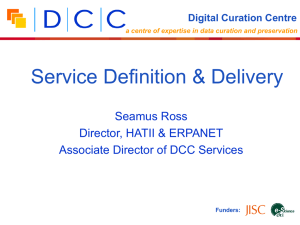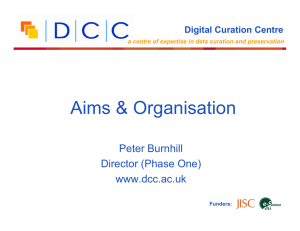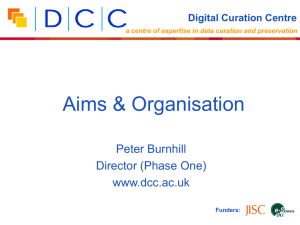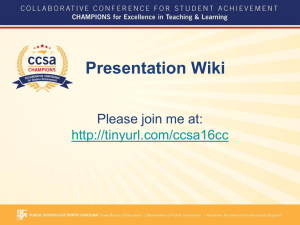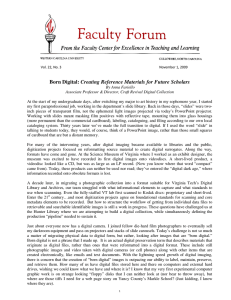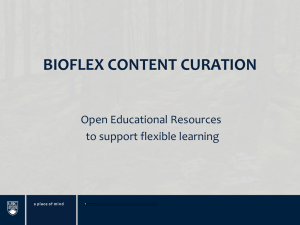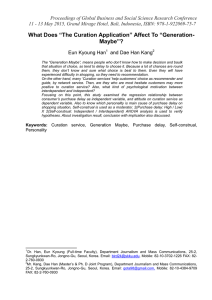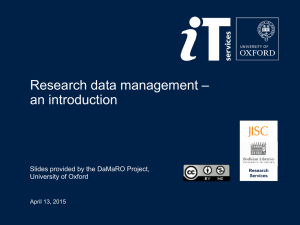Community Stories and Institutional Stewardship: Digital Curation’s Dual Roles of Story Creation and
advertisement
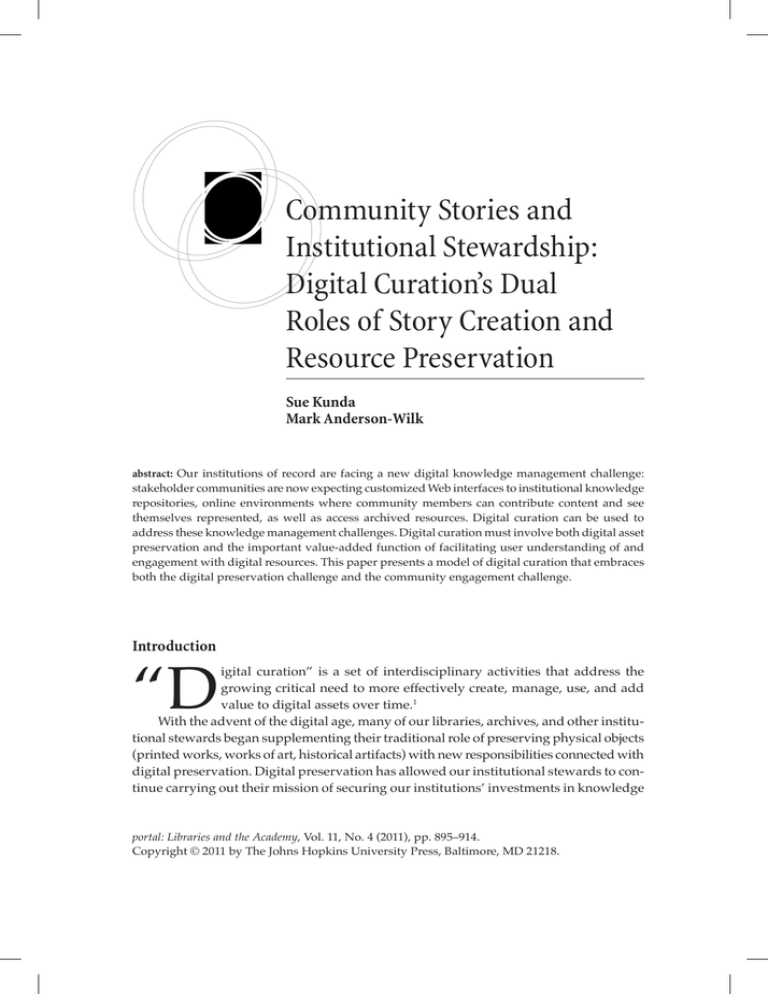
Sue Kunda and Mark Anderson-Wilk Community Stories and Institutional Stewardship: Digital Curation’s Dual Roles of Story Creation and Resource Preservation Sue Kunda Mark Anderson-Wilk abstract: Our institutions of record are facing a new digital knowledge management challenge: stakeholder communities are now expecting customized Web interfaces to institutional knowledge repositories, online environments where community members can contribute content and see themselves represented, as well as access archived resources. Digital curation can be used to address these knowledge management challenges. Digital curation must involve both digital asset preservation and the important value-added function of facilitating user understanding of and engagement with digital resources. This paper presents a model of digital curation that embraces both the digital preservation challenge and the community engagement challenge. Introduction “D igital curation” is a set of interdisciplinary activities that address the growing critical need to more effectively create, manage, use, and add value to digital assets over time.1 With the advent of the digital age, many of our libraries, archives, and other institutional stewards began supplementing their traditional role of preserving physical objects (printed works, works of art, historical artifacts) with new responsibilities connected with digital preservation. Digital preservation has allowed our institutional stewards to continue carrying out their mission of securing our institutions’ investments in knowledge portal: Libraries and the Academy, Vol. 11, No. 4 (2011), pp. 895–914. Copyright © 2011 by The Johns Hopkins University Press, Baltimore, MD 21218. 895 896 Community Stories and Institutional Stewardship creation for present and future users and stakeholders. However, digital preservation is only one aspect of the larger, necessarily collaborative role of digital curation. In the last several years, with the rise of Web 2.0 and social computing, our institutions of record are facing a new digital curation challenge: stakeholder communities of interest2 are now expecting customized Web interfaces to the institutional knowledge repositories, online environments where community members can contribute content and see themselves represented, as well as access the archived resources. This paper describes a model for digital curation that embraces both the digital preservation challenge and the community engagement challenge. The rationale for addressing both community engagement (through stories) and institutional stewardship (through digital preservation) is clear: preservation efforts in isolation run the risk of creating “digital mortuaries”3 of unused . . . preservation efforts in isolation materials that will not continue to receive sustaining support indefinitely; conversely, run the risk of creating “digital user-generated digital content creation mortuaries” of unused materials without a preservation strategy fails to respond to Lynch’s recognition “that the that will not continue to receive intellectual life and scholarship of our unisustaining support indefinitely . . . versities will increasingly be represented, documented, and shared in digital form, and that a primary responsibility of our universities is to exercise stewardship over these riches: both to make them available and to preserve them.”4 Thus, digital curation must involve both digital asset preservation and the important value-added function of facilitating user understanding of and engagement with the digital resources.5 Digital curators in this model are both stewards of . . . digital curation must involve both digital resources (such as electronic digital asset preservation and the files and associated metadata) and facilitators of users’ experience, reimportant value-added function of flection, and learning.6 facilitating user understanding of and engagement with the digital resources. Objectives Oregon State University Libraries (OSUL) and Extension and Experiment Station Communications (EESC) have partnered to formulate a model that can be used by OSUL and other libraries to collaborate with various communities of interest to develop curated Web spaces that meet the communities’ needs and represent their interests, while at the same time carry out the responsibility of digitally preserving the university’s wealth of research, teaching, and outreach products. We argue herein that these two essential components—community stories (achieved through curated Web spaces) and institutional stewardship (achieved through digital preservation)—must be addressed together in one model in order to successfully carry out the new collaborative mission of digital curation. Sue Kunda and Mark Anderson-Wilk Methods A literature review facilitated an understanding of existing work related to digital curation. In order to provide a robust, interdisciplinary foundation for our digital curation model, we examined literature in the following areas: • Understanding of science (knowledge creation, science communication) • Museum studies (curation, exhibition) • Library science (digital preservation, institutional repositories) Existing digital curation models—that of the Digital Curation Centre in the UK7 and the Digital Curation Unit in Greece8—were reviewed for their depth of perspective on the subject. OSUL and EESC also used their existing collaboration and work with additional stakeholder communities of interest to identify and understand the needs that could be addressed by digital curation efforts at Oregon State University and beyond. The information gathered enabled the identification of two high-value needs, both of which could be addressed through digital curation: (1) community engagement and (2) digital preservation. This provided the foundation on which we developed a conceptual model for effective digital curation, which we call the Stories and Stewardship Digital Curation Model. In addition, two local case studies demonstrate how the Stories and Stewardship Digital Curation Model might look in practice: • Oregon Explorer Natural Resources Digital Library • Oregon State University Extension Catalog The study’s conclusions review the implications for libraries, archives, and other digital stewards. Community Story Creation Science as Story, Communicator as Curator Our concept of story creation is, broadly, the act of making digital resources useful. Story creation involves presenting a narrative that allows users to better understand the substance, context, and implications of information. The story may be told with Story creation involves presenting a text, images, sounds, or any combination. Stories are a way of making sense of narrative that allows users to better facts, a way of understanding the natural understand the substance, context, world.9 People find stories more powerful than raw data or observations. Gershon and implications of information. and Page explain that it is “easier to understand information integrated into stories than information spelled out in serial lists.”10 With the example of using storytelling to communicate complex issues related to renewable energy, Monica Leggett and Marie Finlay demonstrate that “storytelling works at the level of the unconscious to enable meaning to become manifest.”11 Storytelling also has the power to create excitement about learning and provide a rich, engaging experience for users.12 897 898 Community Stories and Institutional Stewardship Storytelling is not only compatible with science; it is an important part of the scientific process. A hypothesis, a summary of observations, an interpretation, a theory, an understanding, an explanation—all these common products of science are forms of stories.13 Paul Grobstein notes that as new observations are made (new experiments, data, etc.), existing stories (hypotheses) must be reexamined and revised. Thus, the curator’s job includes regularly reviewing and refreshing the stories. In this way, Grobstein reminds us, science is not a claim of truth, but rather an interpretation (a story) that is continually open for testing against new observations. The scientist has a long-time partner in creating and communicating these stories— the science communicator. The science communicator takes many forms (editor, science writer, photographer, illustrator, videographer, multimedia producer, etc.). In our Stories and Stewardship Digital Curation Model, the science communicator, representing and working closely with the scientific community of interest, is the curator who ensures the stories are told in ways that engage and transform audiences. Curator as Facilitator of Community Meaning Making Though our initial center of interest was the curation functions of libraries and science communicators in educational institutions, we made a conscious effort to stretch our scope of review to other areas, including museum studies, to encourage the cross-pollination of ideas. Libraries, publishers, developers of online educational science exhibits, and the museum community (especially science and natural history museums) can all learn and benefit from each others’ experiences and perspectives on digital curation. An example of the fruitful collaboration between universities and museums has been documented in the partnership between the University of Houston College of Education Instructional Technology Program and the Museum of Fine Arts, Houston.14 The term curation, of course, has a long history in describing the roles museums play vis-à-vis their collections and exhibits, which is not only to protect them and to provide access to them, but also to add value in numerous other ways—for example, through signage, documentation, and educational programs. Beagrie summarizes it this way: “In the library and museum sector, curation centers on well-established concepts of added value from themed collection-building around physical objects (the sum being greater than the parts); from the documentation accompanying individual objects and collections, which provides the relevant context and history for research, learning, and discovery; and from the skills, domain expertise, and knowledge of the staff, the curators of the collections.”15 The value of community stories is also present in the museum literature. Curation can create a narrative that users need to understand and benefit from the objects in an exhibit.16 As an example, the Alexander Fleming Museum in London effectively uses the life of Alexander Fleming to tell the important story of penicillin.17 The definition of curator has been undergoing transformation and growth in the museum world and elsewhere. Traditionally, the curator had the role of an expert who delivers knowledge or educational information about a collection’s objects. A more contemporary concept of a curator is one of collaborator, broker, or storyteller. The curator is the moderator or facilitator of conversations about the objects in an exhibit, “an expert Sue Kunda and Mark Anderson-Wilk communicator and interpreter, stimulating interest and helping audiences navigate to the information sources that satisfy their curiosity.”18 Ted Ansbacher contrasts the traditional educational model, knowledge being disseminated from experts to individuals, with the experience-based learning model initially envisioned by John Dewey, where individuals gain new knowledge and understanding through their experiences.19 Angelina Russo et al explain that curation is changing from a one-to-many (expert-to-audience) model to a many-to-many model (where curation is a hub of community participation).20 Similarly, Lois Silverman describes how museums in the past followed the “information paradigm” communication theory, which suggests information is passed in messages from a sender to a receiver, as opposed to the more contemporary participatory, user-centered communications paradigm.21 In some museums, the role of curator is adjusting to fit the constructivism learning theory, where visitors are encouraged to make meaning through engaging their own cycles of experience, emotion, and thinking.22 By opening up an exhibit to visitors (and we could extend that to publishing a Web exhibit), we create the situation where the visitors will make meaning.23 Tom Hennes views exhibits . . . the role of curator is adjusting to fit as platforms for experiences or the constructivism learning theory, where encounters. Encounters can occur between individuals and objects, visitors are encouraged to make meanbetween people, and within our- ing through engaging their own cycles of selves (for example, the exhibit brings up something we didn’t experience, emotion, and thinking. realize about ourselves). It is the job of the curator to create a platform for an encounter where the stakeholder community can see themselves in a new, transformative way. Hennes concludes the curator thus gives “that community a means to formulate a more coherent knowledge of who it is.”24 This is part of a shift in museum focus away from objects, and their intrinsic value, toward object histories and their interpretive contexts, recognition that knowledge itself is contextual and exists within the relationship between people and objects.25 Elaine Gurian challenges curators to examine whether their museums value visitors or objects more: is the museum an instructor to audiences or a collaborator with them?26 Stories Worth Telling and Telling Well Story sharing is a powerful activity, with the potential to engage the thoughts, emotions, and actions of audiences. But there are plenty of stories of all qualities and not enough time to experience them all. So, for curated Web spaces to work effectively as vehicles of community engagement, the stories must be carefully selected and developed. The first element in identifying the seeds of a story may be in listening to the stakeholder communities of interest. What issues are the communities dealing with? What topics arouse their interest? Is there a person or project that represents a given community, in which the community sees itself? In the sciences, an additional requirement is that the stories be realistic given current evidence, able to be tested and reproduced or modified, and fit with existing explanations 899 900 Community Stories and Institutional Stewardship of the natural world.27 Failure to meet this standard will reduce the story’s trustworthiness and credibility with stakeholder communities. Knowledgeable scientists must be able to agree on the basic rationality of the story, vetted through peer review or technical review by respected members representing the primary communities of interest. The basic objectives of storytelling in this context are to ignite the interest of the audience and to convey the story in a way that the audience can find meaning and relevance. The basic elements of good digital storytelling are as follows:28 • Right topic. What is the purpose of the story or specific question that is being addressed? What is it about? • Human subject. Who is the primary actor in the story? Whose story is it? • Narrator. Is the story told with a distinct voice and point of view? • Narrative. Does the storyline have an effective plot and structure, events connected to a sense of time, with a beginning, middle, and end? • Artfulness. Does the story delivery include a sense of economy, grace, poetry, and pacing? • Emotion. Does the story attend to the audience, create an emotional connection, a way for These basic elements of good storytelling can be used with any combination of media (text, images, video, audio, etc.). Curated Web spaces, as proposed in the Stories and Stewardship Digital Curation Model, provide a framework for digital storytelling to engage communities of interest with a coherant, compelling narrative. These curated Web spaces can be considered online exhibits and can benefit from guidelines for making museum exhibits meaningful:29 • Embed a sense of purpose in the exhibit based on what visitors care about. • Help the visitors connect with the exhibit by tapping into their familiar points of reference. • Use storytelling to bring out the relationships between the objects, the visitors, and their world. • Provide information in a form that audiences can access emotionally. • Design the environment using spatial language to help visitors make sense of things. • Recognize that visitors create their own experiences; the important outcome will occur from within the visitor. Institutional Stewardship Cultural Heritage Institutions and Digital Preservation Stewardship of cultural resources has always been a primary function of cultural heritage institutions.30 Preservation was defined as “the professional discipline of protecting materials by minimizing chemical and physical deterioration and damage to minimize the loss of information and to extend the life of cultural property.”31 Cultural heritage institutions focused preservation programs on maintaining security and optimizing the control of environmental factors to minimize and stabilize material degradation. Sue Kunda and Mark Anderson-Wilk In the late twentieth and early twenty-first centuries, those responsible for the stewardship of cultural resources recognized the importance of preserving their increasingly digital assets.32 With their complexity and instability, digital objects provide preservation challenges formerly unfamiliar to cultural heritage institutions. Unlike their analog counterparts, digital assets require stewardship practices and techniques designed to avoid degradation of digital objects and maintain technical environments necessary for retrieval, reading, use, and re-use of the items. Practitioners struggle not only with the technological issues but also must deal with conflicting stakeholder interests, Practitioners struggle not only institutional ambivalence, an onerous and fluctuating legal environment, and limited with the technological issues but resource allocation.33 also must deal with conflicting The scope of this paper does not stakeholder interests, institutional permit a detailed analysis of digital preservation strategies, nor does it allow for a ambivalence, an onerous and thorough discussion of the human inter- fluctuating legal environment, and vention and organizational commitment upon which digital preservation depends. limited resource allocation. We, therefore, limit our discussion to defining digital preservation and providing a possible solution that addresses some of the inherent obstacles as related to our definition of digital curation. Numerous authors and organizations provide definitions of digital preservation.34 The Research Libraries Group defines it as “the managed activities necessary for ensuring both the long-term maintenance of a byte stream and continued accessibility of its contents.”35 The Digital Preservation Coalition refers to digital preservation as “the series of managed activities necessary to ensure continued access to digital materials for as long as necessary.”36 In its 2002 “Plan for the National Digital Information Infrastructure and Preservation Program,” the Library of Congress describes the goal of digital preservation thus: “to maintain an information asset so that is it is readily accessible for use, no matter what format it was originally in, and ensuring that it is authentic and reliable by preventing such things as tampering, accidental corruption of files, media degradation, and losses through software and hardware obsolescence.”37 Digital preservation, then, requires cultural heritage institutions to archive and provide access to digital objects indefinitely. Institutional repositories have been designed and implemented to address this need.38 Institutional Repositories Institutional repositories (IRs), modeled after discipline-based e-print servers, which provided early and open access to research, got their start in the earlier part of the twentyfirst century.39 With the advent of the first two major IR software systems—ePrints in the UK, developed at the University of Southampton, and DSpace in the United States, developed through a joint project between the Massachusetts Institute of Technology and Hewlett Packard—universities had a means to gather, store, and provide access to the intellectual output of their campuses. 901 902 Community Stories and Institutional Stewardship Many early repositories focused solely on the collection, management, and dissemination of faculty and student research and scholarship, but as Richard Johnson from the Scholarly Publishing and Academic Resources Coalition (SPARC) notes, “in practice, institutional repositories can assume many forms and serve a variety of purposes.”40 An examination of the top 400 IRs, as enumerated by Webometrics, bears this statement out.41 The list includes repositories supporting universities, laboratories, scientific foundations, digital libraries, regional consortiums, and numerous other institutions (figure 1); items include faculty publications, student theses and dissertations, data sets, maps, multimedia, news reports, and educational resources. Figure 1. Webometrics Ranking of Institutional Repositories Conflating this broad characterization of IRs with strategy (e.g., ensuring open access, combating the high price of serials, showcasing intellectual output) complicates the definition of IRs. Clifford Lynch, during a Coalition for Networked Information Task Force Meeting, remarked that you “need to know who you’re talking to about institutional repositories to understand exactly what conversation you’re having.”42 In 2002, Crow defined institutional repositories as “digital collections capturing and preserving the intellectual output of a single or multi-university community.”43 Lynch provided perhaps the most oft-quoted description of IRs, as being “a set of services that a university offers to the members of its community for the management and dissemination of digital materials created by the institution and its community members. It is most essentially an organizational commitment to the stewardship of these digital materials, including long-term preservation where appropriate, as well as organization and access or distribution.”44 Sue Kunda and Mark Anderson-Wilk Many authors have since added to, and expanded, Crow’s and Lynch’s early definitions of an IR.45 For the purposes of this paper we describe an IR as a digital repository designed for the collection, preservation, and dissemination of an institution’s digital assets. With its preservation function, an IR can provide the vehicle for the “institutional stewardship” aspects of our digital curation model, but it is important to note that an IR cannot stand alone as a digital preservation solution.46 Wilczek and Glick contend, “Without the appropriate people, infrastructure, policies, and procedures, even the best [IR platform] cannot ensure preservation.”47 Just as with digital preservation, the effectiveness of an IR is tied to human intervention and institutional commitment. Functions and Services of Digital Preservation The functions and services commonly associated with digital preservation activities and available in many IR platforms include permanent storage, bit preservation, persistent identifier, provenance information, preservation metadata, interoperability, and discoverability. Those functions providing the greatest impact on the ability of an IR to provide the “institutional stewardship” aspects of digital curation are discussed below. Most IRs adhere to standards such as the Dublin Core Metadata Element Set and support the Open Archives Initiative protocol for metadata harvesting.48 A. M. C. Moura et al define metadata as “information that makes data useful;”49 a digital resource’s metadata affects whether and how the resource is used. Metadata can improve the discoverability of a published resource and can facilitate the exchange of a variety of information related to the resource.50 Without metadata, digital assets are likely to remain inaccessible to all but serendipitous discovery. Most IRs are designed to be interoperable.51 Interoperability (the ability to share information with other systems) is one of the important requirements of a digital curation system. IRs are often noted for their discoverability. Because of the open, metadata-rich, interoperable nature of IRs repositories, users can discover materials in IRs through a variety of search mechanisms, including Google searches.52 Stories and Stewardship Digital Curation Model Figure 2 provides a conceptual model for digital curation that embraces both community story creation and digital preservation stewardship. The literature review documented above and our internal assessment of OSUL community collaboration needs were used to develop the model. As indicated in the figure, community Web spaces are online locations where community stories are created, objects are made useful and meaningful, contextualization and interpretation are facilitated, user experience is encouraged and valued, relationships are fostered, and community identity is formed. The stewardship core is where the institutional steward carries out best practices in digital preservation, metadata, interoperability, and discoverability. Any proposed model, of course, needs to be sustainable for institutions and community partners to be willing to invest in it. To understand the sustainability issue from 903 904 Community Stories and Institutional Stewardship Figure 2. Stories and Stewardship Digital Curation Model the perspective of digital curation, we looked to the definition provided by William LeFurgy, digital initiatives project manager at the Library of Congress: “Digital curation sustainability [is] meeting the needs of the present without compromising the ability of future generations to meet their own needs.”53 Note that this definition emphasizes the needs of present day users. As we cannot predict what the specific needs of future generations will be, the sustainability of digital curation should be based on making sound decisions for today that will not impede future generations from making whatever decisions they choose to make. Thus, our model provides both (1) the digital preservation functions of the institutional repository so that future generations will have access to these assets and their metadata, and, (2) the community engagement functions of the curated Web spaces, where stories are used to make the digital assets meaningful to present day stakeholders. Each collaborative Web space is scaled to the needs of a given community, produced with collaboration between the institutional steward (the library) and the community (e.g., department, center, or discipline), and designed to undergo continuing change, as new stories are essential to describe the community’s contemporaneous requirements and knowledge. The necessary Web development and science communication expertise could come from the steward, the community, by contract with an outside agent, or some combination. The use and interaction that takes place between the community and the digital resources, within the curated Web space, is the breeding ground for new, improved formulations of knowledge, which are then deposited into the IR. The user’s experience with the digital resources (including session logs, observational data produced by the Sue Kunda and Mark Anderson-Wilk interaction of users with the resources such as social tags and annotations, and other Web 2.0 artifacts) could be progressively added to the metadata. In this way, the digital assets in the IR provide the building blocks of community stories, and the community engagement with the stories in turn provides enrichment of the The use and interaction that takes place IR. The arrows in the figure indicate this concept of knowledge between the community and the digital creation and life cycle. resources, within the curated Web space, A life cycle approach to is the breeding ground for new, improved digital curation is also present in both the Digital Curation Centre formulations of knowledge, which are model and the Digital Curation then deposited into the IR. Unit model. As noted by Pennock, curation activities, or lack thereof, at each stage in the digital life cycle impact the value of the digital resources at subsequent stages of the life cycle.54 Thus, ongoing use of the curated Web spaces amplifies the impact of the initial commitment to the model. It is also valuable to note that the life cycle approach to digital knowledge management allows us to reframe our thinking from a focus on discrete digital objects to the living, interactive, continually refining relationships between people and the objects. For, as Costis Dallas suggests, knowledge exists within the relationship between people and the objects.55 The Stories and Stewardship Digital Curation Model thus is a framework for changing our concept of the product of digital curation from a digital shelving system to a digital knowledge ecosystem. Case Studies The Stories and Stewardship Digital Curation Model is flexible and open enough to fit a variety of situations. In fact, a number of existing projects can be shown to demonstrate how the model could be applied in working contexts. Two Oregon State University projects are described below. These case studies represent solutions to two very different needs in a range of contexts, but they both possess the basic components of the Stories and Stewardship Digital Curation Model. Oregon Explorer Established with a grant from the Oregon Watershed Enhancement Board and matched with funding from OSU Libraries and Institute of Natural Resources, Oregon Explorer (OE) is a Web-based portal to Oregon natural resources (http://oregonexplorer.info/; see figure 3). OE contains the data, information, and tools Oregon scientists, public officials, and citizens need to make informed decisions about Oregon’s natural environment. OSUL’s IR, ScholarsArchive@OSU (https://ir.library.oregonstate.edu/xmlui/), provides preservation for the data, reports, and publications submitted to the OE collection, but it is the user-centered story creation that makes OE truly unique. The OE vision statement provides an overarching framework for the community digital curation model described earlier in this paper: “The Oregon Explorer is envisioned to use the power of today’s cutting edge information technology to create a state-of-the-art Web-accessible 905 906 Community Stories and Institutional Stewardship Figure 3. Oregon Explorer Website natural resources digital library by way of accessing and integrating data from state and federal agencies, local governments, university scientists and citizens to support informed decisions and actions by people concerned with Oregon’s natural resources and environment.”56 It is this “integrating data from state and federal agencies, local governments, university scientists and citizens” that informs the story creation aspect of digital curation within OE.57 In addition to providing access to the data, reports, and publications, the OE team sees story creation as an integral component of their mission. Science writers, in-house specialists, and members of the OE team craft compelling stories to contextualize data sets and simplify complex technical information for a broad lay audience. The group is determined to give Oregon citizens a reason to care about the critical issues affecting state policy-making decisions. OE’s goals and objectives also directly address the value of including users in the creation and understanding of information. Taken directly from the OE Website, users are encouraged to “share their information with others in order to create and build shared understanding about Oregon’s natural resource and environmental issues, problems, and opportunities and build community networks.”58 Groups of interest have provided documents and images, while visitors to the OE portal are invited to submit their resources through ScholarsArchive@OSU. The OSU Rural Studies Program regularly holds community-wide contests in order to acquire historical accounts of rural life in Oregon for use in OE (Figure 4). While users’ submissions are encouraged, OE uses a variety of tactics to evaluate the materials before adding them to the website. Groups of interest usually contact the OE team with suggestions for related documents, giving OE staff the opportunity to look over the items and approve (or not approve) their inclusion in OE. OSUL staff vets items submitted directly through ScholarsArchive@OSU, with OE team members available for Sue Kunda and Mark Anderson-Wilk Figure 4. Oregon Explorer Rural Oregon Studies guidance if necessary. Contests such as those held by the Rural Studies Program, invite story submissions from a wide swath of Oregon citizens, and ultimately, Rural Studies Program staff serve a digital curation function by making the decision whether or not to include contest entries in OE. Extension Publishing Oregon State University Extension and Experiment Station Communications (EESC) came to the Stories and Stewardship Digital Curation Model through a long, iterative process of continually seeking to achieve its mission—sharing the knowledge of the university with the people of the state—through changing times and technologies. The Oregon State University Extension Service has been publishing (creating and distributing) research-based educational resources since 1909, representing the university’s leading mechanism of community impact and engagement. The primary method of dissemination through most of this time was, of course, printed copies of publications available at libraries, Extension offices, educational workshops, and by mail. With the advent of the World Wide Web in the 1990s, EESC began making the Extension resources it publishes available digitally by posting them on its local website, in addition to the traditional methods of distribution. The advantages of delivering information to users at any time and any place were clear. The sustainability of this model, or lack thereof, was less obvious in the early days of the Web. Over time, EESC recognized several major inadequacies in the first generation of digital publishing. The practice of just posting files to a local website didn’t address the need to preserve digital resources after they are deemed “out of date” and removed from the website. It also didn’t provide a way to avoid the link rot that would occur from the resources being hyperlinked across the Web and then moved, renamed, or removed. Thus, in 2009, EESC and OSUL developed an approach to publishing new 907 908 Community Stories and Institutional Stewardship Extension materials. The files and metadata are deposited into ScholarsArchive@OSU (figure 5) and the ensuing permanent link is placed into the community user interface of the Extension Catalog (figure 6). Figure 5. EESC Publication in ScholarsArchive@OSU Figure 6. EESC Publication Listing in Extension Catalog Sue Kunda and Mark Anderson-Wilk To further make the Stories and Stewardship Digital Curation Model a tangible reality for the citizens of Oregon, EESC extended the Extension Catalog into curated Web spaces, where stories are created for various communities of interest around such topics as gardening, small farms, food preservation, food and nutrition, family and youth, and health and wellness (see figure 7 from the OSU Extension website). Communities of interest now engage with Extension resources in Web spaces designed specifically around their needs. Figure 7. EESC Curated Web Spaces for “Get Good at It” How-to Communities The partnership between OSUL and EESC/Extension is ideal for the collaborative nature of the Stories and Stewardship Digital Curation Model: OSUL is the steward of Oregon State University’s institutional repository, ScholarsArchive@OSU, with library science expertise in cataloging, digital preservation, access, and discovery. The university’s Extension Service represents both the content knowledge of faculty in academic 909 910 Community Stories and Institutional Stewardship departments and the university’s living relationships with cities, town, and counties across the state, professional and scientific societies, industry groups, and agricultural grower associations, and other stakeholder groups and communities of interest. Land grant universities such as Oregon State University have over 100 years of experience sharing knowledge with communities and listening to community interests and concerns that they can use to benefit the design and moderation of curated community Web spaces. In addition, EESC is a department of professional communicators with the skills and expertise to help the Extension scientists effectively communicate the stories of their communities of interest. Conclusions Heatley has called for land grant universities to establish an effective system to preserve, manage, and provide access to digital information.59 This need extends to many university and research libraries, scientific organizations, museums, historical societies, and other cultural institutions. The challenge of effectively managing the digital representation of knowledge is complex. It requires collaboration from many disciplines and affects all sorts of institutions. Digital assets are both vulnerable and reproducible. Digital archives may be loaded with data, but they are only useful and meaningful when processed and understood by humans. A system that focuses exclusively on preserving digital content doesn’t take advantage of the living, social, experiential Web, where users are not satisfied to passively receive information as they did in the past, and now demand a role in contributing and engaging with others in Web environments. This set of user-focused problems (the engagement challenge) calls for involvement of users in A system that focuses exclusively on preserv- the the co-construction of digital ing digital content doesn’t take advantage knowledge. “Digital curation” is the of the living, social, experiential Web, where term that is being used with users are not satisfied to passively receive increasing frequency to deinformation as they did in the past, and now scribe the activities that addemand a role in contributing and engaging dress the digital preservation and knowledge management with others in Web environments. challenges. It is clear that in the coming years, digital curation will be an increasingly important function for libraries and cultural heritage institutions charged with the stewardship of digital assets.60 At the same time, the viability of our institutions is closely tied to their ability to meet the needs of stakeholder communities of interest. This paper presents a model of digital curation that embraces both the digital asset management challenge and the community engagement challenge. The model provides a framework for institutional stewards to collaborate with various communities of interest to develop curated Web spaces that meet the communities’ needs and represent Sue Kunda and Mark Anderson-Wilk their interests, while at the same time carrying out the responsibility of preserving the institution’s wealth of digital assets and investment in knowledge creation. As suggested by the Stories and Stewardship Digital Curation model, we believe that community stories and institutional stewardship are both necessary components for libraries and other cultural heritage organizations to effectively carry out their digital preservation responsibilities with integrity and sustainability. This model may be useful in many cases where an institution of record (such as a library or archive) and a stakeholder community of interest (such as a research center or community organization) can mutually benefit from working together to engage audiences and preserve the investment for the benefit of future generations. Sue Kunda is digital scholarship librarian, Oregon State University Libraries; she may be contacted via e-mail at: sue.kunda@oregonstate.edu. Mark Anderson-Wilk is publishing leader, Extension and Experiment Station Communications, Oregon State University; he may be contacted via e-mail at: mark.anderson-wilk@oregonstate.edu. Notes 1. Neil Beagrie, “Digital Curation for Science, Digital Libraries, and Individuals,” International Journal of Digital Curation, 1, 1 (2006): 3–16; Maureen Pennock, “Digital Curation: A LifeCycle Approach to Managing and Preserving Usable Digital Information,” Library and Archives, 1 (2007); Panos Constantopoulos et al, “DCC&U: An Extended Digital Curation Lifecycle Model,” International Journal of Digital Curation 4, 1 (2009): 34–45. 2. We use “communities of interest” as an alternative term for “communities of practice,” a concept pioneered by Jean Lave and Etienne Wenger in Situated Learning: Legitimate Peripheral Participation, (New York: Cambridge University Press, 1991). Lave and Etienne speculated that learning occurs through social connections (communities) forged by mutual interests—i.e., communities of practice. 3. Beagrie, “Digital Curation,” 5. 4. Clifford A. Lynch, “Institutional Repositories: Essential Infrastructure for Scholarship in the Digital Age,” ARL Bimonthly Report 226 (Washington, DC: Association of Research Libraries, 2003), 2. 5. Beagrie, “Digital Curation.” 6. Costis Dallas, “An Agency-Oriented Approach to Digital Curation Theory and Practice,” in International Cultural Heritage Informatics Meeting (ICHIM07): Proceedings, ed. J. Trant and D. Bearman (Toronto: Archives and Museum Informatics, 2007). 7. Chris Rusbridge et al, “The Digital Curation Centre: A Vision for Digital Curation,” paper presented at From Local to Global: Data Interoperability—Challenges and Technologies, IEEE Computer Society, Sardinia, Italy, June 20–24, 2005; Pennock, “Digital Curation”; Sarah Higgins, “The DCC Curation Lifecycle Model,” International Journal of Digital Curation 3, 1 (2008): 134–140. 8. Constantopoulos, “DCC&U. 9. Lucy Avraamidou and Jonathan Osborne, “Science as Narrative: The Story of the Discovery of Penicillin,” Pantaneto Forum 31 (2008). 10. Nahum Gershon and Ward Page, “What Storytelling Can Do for Information Visualization,” Communications of the ACM 44, 8 (2001): 31. 11. Monica Leggett and Marie Finlay, “Science, Story, and Image: A New Approach to Crossing the Communication Barrier Posed by Scientific Jargon. Public Understanding of Science 10, 2 (2001): 161. 911 912 Community Stories and Institutional Stewardship 12. Stephen Rowcliffe, “Storytelling in Science,” School Science Review 86, 314 (2004): 121–126; Avraamidou, “Science as Narrative.” 13. Paul Grobstein, “Revisiting Science in Culture: Science as Story Telling and Story Revising. Journal of Research Practice 1, 1 (2005): M1; Roald Hoffmann, “Storied Theory,” American Scientist 93 (2005): 308–10; Barry R. Bickmore et al, “Science as Storytelling for Teaching the Nature of Science and the Science-Religion Interface,” Journal of Geoscience Education, 57, 3 (2009): 178–190. 14. Bernard Robin, A. Jenkins, W. Howze, and K. O’Connor, “A Museum-University Partnership to Develop Web-Based Educational Resources,” paper presented at the 2001 Museums and the Web Conference, Seattle, WA, 2001; S. Wilson McKay et al, “The Evolution of Webscapes: A Theoretical Framework for the Collaborative Design and Development of Interactive Learning Environments,” in Proceedings of World Conference on Educational Multimedia, Hypermedia and Telecommunications 2003, ed. D. Lassner and C. McNaught (Chesapeake, VA: Association for the Advancement of Computing in Education, 2003): 3038–3039. 15. Beagrie, “Digital Curation,” 4–5. 16. Dallas. “Agency-Oriented Approach.” 17. Avraamidou, “Science as Narrative.” 18. Nancy Proctor, “Digital: Museum as Platform, Curator as Champion, in the Age of Social Media,” Curator: The Museum Journal 53, 1 (2010): 38. 19. Ted Ansbacher, “Experience, Inquiry, and Making Meaning,” Exhibitionist 18, 2 (1999): 22–26. 20. Angelina Russo et al, “Participatory Communication with Social Media,” Curator: The Museum Journal 51, 1 (2008): 21–31. 21. Lois H. Silverman, “Meaning Making Matters: Communication, Consequences, and Exhibit Design,” Exhibitionist 18, 2 (1999): 9–14. 22. Silverman, “Meaning Making Matters”; Jay Rounds, “Meaning-Making: A New Paradigm for Museum Exhibits?” Exhibitionist 18, 2 (1999): 5–8; Ansbacher, “Experience, Inquiry”; Russo, “Participatory Communication.” 23. George E. Hein, “Is Meaning Making Constructivism? Is Constructivism Meaning Making?” Exhibitionist 18, 2 (1999): 15–18. 24. Tom Hennes, “Exhibitions: From a Perspective of Encounter,” Curator 53, 1 (2010): 31. 25. Dallas, “Agency-Oriented Approach.” 26. Elaine Heumann Gurian, “Museum as Soup Kitchen,” Curator 53, 1 (2010): 71–85. 27. Bickmore, Science as Storytelling. 28. Eugene Dillenburg, “‘The Sound Must Seem an Echo to the Sense’: Meaning Making in Poetry and Exhibits,” Exhibitionist 18, 2 (1999): 35–37; Bernard R. Robin, “The Educational Uses of Digital Storytelling,” in Proceedings of Society for Information Technology & Teacher Education International Conference 2006, ed. C. Crawford et al. (Chesapeake, VA: Association for the Advancement of Computing in Education, 2006): 709–16; Avraamidou, “Science as Narrative.” 29. John Chiodo and Alissa Rupp, “Setting the Stage for Meaningful Exhibits,” Exhibitionist 18, 2 (1999): 19–21. 30. Margaret Hedstrom, “Digital Preservation: A Time Bomb for Digital Libraries,” Computers and the Humanities 31, 3 (1998): 189–202; Deanna Marcum and Amy Friedlander, “Keepers of the Crumbling Culture: What Digital Preservation Can Learn from Library History,” D-Lib Magazine 9, 5 (2003); Oya Rieger, Preservation in the Age of Large-scale Digitization: A White Paper. (Washington, DC: Council on Library and Information Resources, 2009); Jeffrey Horrell, “Converting and Preserving the Scholarly Record: An Overview,” Library Resources & Technical Services 52, 1 (2008). 31. Richard Pearce-Moses, “A Glossary of Archival and Records Terminology,” Society of American Archivists, http://www.archivists.org/glossary/term_details.asp (accessed January 31, 2011). Sue Kunda and Mark Anderson-Wilk 32. Terry Kuny, “A Digital Dark Ages? Challenges in the Preservation of Electronic Information,” paper presented at the 63rd International Federation of Library Associations and Institutions Council and General Conference, Copenhagen, Denmark, August 31– September 4, 1997; Hedstrom, “Digital Preservation”; Brian Lavoie and Lorcan Dempsey, “Thirteen Ways of Looking at ... Digital Preservation,” D-Lib Magazine 10, 7/8 (2004); Beagrie, “Digital Curation”; Constantopoulos, “DCC&U.” 33. Anne R. Kenney and Oya Rieger, Moving Theory into Practice: Digital Imaging for Libraries and Archives (Mountain View, CA: Research Libraries Group, 2000); MacKenzie Smith, “Exploring Variety in Digital Collections and the Implications for Digital Preservation,” Library Trends 54, 1 (2005): 6–15. 34. Hedstrom, “Digital Preservation”; Rieger, Preservation in the Age; Smith, “Exploring Variety”; Association for Library Collections and Technical Services, “Definitions of Digital Preservation,” American Library Association, http://www.ala.org/ala/mgrps/divs/alcts/ resources/preserv/defdigpres0408.cfm (accessed January 31, 2011). 35. Research Libraries Group, Trusted Digital Repositories: Attributes and Responsibilities. (Mountain View, CA: Research Libraries Group, 2002). 36. Digital Preservation Coalition, “Introduction – Definitions and Concepts,” http://www. dpconline.org/advice/preservationhandbook/introduction/definitions-and-concepts (accessed February14, 2011). 37. Library of Congress (2002). “Preserving our Digital Heritage: Plan for the National Digital Information Infrastructure and Preservation Program: A Collaborative Initiative of the Library of Congress.” http://www.digitalpreservation.gov/library/resources/pubs/ docs/ndiipp_plan.pdf (accessed February 15, 2011). 38. Raym Crow, “The Case for Institutional Repositories: A SPARC Position Paper,” ARL Bimonthly Report 223 (Washington, DC: Association of Research Libraries, 2002); Lynch, “Institutional Repositories”; Mark Ware, “Institutional Repositories and Scholarly Publishing,” Learned Publishing 17, 2 (2004): 115–124. 39. Priscilla Caplan, “Repository Applications,” Library Technology Reports 44, 2 (2008). 40. Richard K. Johnson, “Institutional Repositories: Partnering with Faculty to Enhance Scholarly Communication,” D-Lib Magazine 8, 11 (2002). 41. Webometrics, “Ranking Web of World Repositories: Top 400 Institutional Repositories.” 42. Clifford Lynch, “Revisiting Institutional Repositories,” Project Briefing Section, Coalition for Networked Information Spring 2009 Task Force Meeting (Minneapolis, MN: Coalition for Networked Information), http://vimeo.com/5498937 (accessed January 31, 2011). 43. Crow, “Case for Institutional Repositories.” 44. Lynch, “Institutional Repositories.” 45. Ware, “Institutional Repositories”; Karen Markey et al, “Census of Institutional Repositories in the United States: MIRACLE Project Research Findings,” CLIR Reports, no. 140 (2007), http://www.clir.org/pubs/reports/pub140/contents.html (accessed January 31, 2011); Richard Jones et al, The Institutional Repository (Oxford, UK: Chandos Publishing, 2006); Catherine Jones, Institutional Repositories: Content and Culture in an Open Access Environment (Oxford, UK: Chandos Publishing, 2007); Joseph Branin, “Institutional Repositories,” Encyclopedia of Library and Information Science, second ed. (London: Taylor and Francis, 2004): 1–12; Charles W. Bailey Jr. et al, Spec Kit 292: Institutional Repositories (Washington, DC: Association of Research Libraries, 2006). 46. E. Wilczek and K. Glick, Fedora and the Preservation of University Records Project: Reports and Findings (Boston, MA: Tufts University and Yale University, 2006); Smith; Repository Applications. 47. Wilczek, Fedora. 48. Crow, “Case for Institutional Repositories”; Ware, “Institutional Repositories”. 49. Ana Maria Carvalho Moura et al, “A Survey on Metadata for Describing and Retrieving Internet Resources,” World Wide Web 1, 4 (1998): 221. 913 914 Community Stories and Institutional Stewardship 50. Amy Brand et al, Metadata Demystified: A Guide for Publishers (Hanover, PA: Sheridan Press, 2003); William E. Kasdorf, The Columbia Guide to Digital Publishing (New York, NY: Columbia University Press, 2003). 51. Crow, “Case for Institutional Repositories”; Ware, “Institutional Repositories.” 52. Ibid. 53. Michael Day, “Report from the DigCCurr 2007 International Symposium on Digital Curation, Chapel Hill, NC, April 18–20, 2007,” International Journal of Digital Curation 2, 1 (2007): 105. 54. Pennock, “Digital Curation.” 55. Dallas, “Agency-Oriented Approach.” 56. Oregon State University, “About the Oregon Explorer,” http://oe.oregonexplorer.info/ imagery/about/about.aspx?Res=17120 (accessed July 27, 2011). 57. Oregon State University, “About Oregon Explorer,” http://www.oregonexplorer.info/ about/about.asp (accessed January 31, 2011). 58. Ibid. 59. Randall Heatley, Plan to Develop a Digital Information Infrastructure to Manage Land Grant Information (Lincoln, NE: American Distance Education Consortium, 2007). 60. William Y. Arms and Ronald L. Larsen, The Future of Scholarly Communication: Building the Infrastructure for Cyberscholarship,” Report of a workshop held in Phoenix, Arizona, April 17-19, 2007, sponsored by the National Science Foundation and the Joint Information Systems Committee, http://www.sis.pitt.edu/repwkshop/SIS-NSFReport2.pdf (accessed July 28, 2011).
